Difference between revisions of "Weapon leather"
| Line 11: | Line 11: | ||
==Military leather - Leather and weapons== | ==Military leather - Leather and weapons== | ||
Leather often appears in connection with military and weapons. It was used as armour, as part of the uniform ([[leather belt|belts]], [[Leather belt#Leather straps|straps]], [[Leather boots|boots]]), as holsters for rifles and pistols or as a knife blade. For centuries, leather was an important material for transporting weapons and ammunition, and was part of many uniforms. Even cannon barrels were made from [[parchment|dried skin]]. | Leather often appears in connection with military and weapons. It was used as armour, as part of the uniform ([[leather belt|belts]], [[Leather belt#Leather straps|straps]], [[Leather boots|boots]]), as holsters for rifles and pistols or as a knife blade. For centuries, leather was an important material for transporting weapons and ammunition, and was part of many uniforms. Even cannon barrels were made from [[parchment|dried skin]]. | ||
| + | |||
| + | |||
| + | ==Leather in military history== | ||
| + | The use of leather in military history has a long and important tradition. The material leather has proven to be extremely useful to protect soldiers in various wars and conflicts and improve their combat skills. | ||
| + | |||
| + | * Protection: Leather has been used in the manufacture of armor and protective gear since ancient times. Leather armor and armor have been developed over the centuries to protect the body from stabs, cuts and blows. Leather was also used for [[Leather hat#Leather helmet|helmets]], [[leather shoes|shoes)) and [[leather gloves|gloves]] to provide extra protection for the body parts. | ||
| + | * Toughness and Durability: Leather is a tough and durable material that can withstand the rigors of war. It is resistant to wear, tear and abrasion, making it ideal for use in military equipment. Leather boots, belts and straps were essential parts of soldiers' uniforms to keep their equipment secure and allow freedom of movement. | ||
| + | * Flexibility and freedom of movement: Leather is a flexible material that can adapt well to the shape of the body. This allowed soldiers to move freely and carry out their duties effectively. For example, leather gloves offered a good grip and tactile feedback when handling weapons and other gear. | ||
| + | * Insulation and Comfort: Leather also has insulating properties that allowed soldiers to operate in different climatic conditions. It could retain heat and protect the body from cold. In addition, leather offered a degree of comfort by reducing friction and chafing, which was particularly beneficial during long marches or long engagements. | ||
| + | * Symbolism and Identification: Leather also played an important role in military symbolism and identification. In rank order in particular, certain leather accessories or insignia were used to denote rank or affiliation with a particular unit. | ||
| + | |||
| + | Overall, leather is of great importance in military history. It was not only a practical material for soldiers' protection and functionality, but also a symbol of strength, discipline and military identity. Leather still plays a role in military equipment and uniforms to this day, even though modern materials are increasingly being used. | ||
Revision as of 16:57, 20 June 2023
Contents
- 1 Military leather - Leather and weapons
- 2 Leather in military history
- 3 Pistol holster - Rifle scabbard - rifle case
- 4 Patron belt
- 5 knife sheaths - sword sheaths - saber sheaths
- 6 Protective covers made of leather
- 7 Sword handles made of leather
- 8 Protective clothing
- 9 Bolas - Boleadoras
- 10 Leather shields
- 11 Leather Fly Swatter
- 12 Additional information
Military leather - Leather and weapons
Leather often appears in connection with military and weapons. It was used as armour, as part of the uniform (belts, straps, boots), as holsters for rifles and pistols or as a knife blade. For centuries, leather was an important material for transporting weapons and ammunition, and was part of many uniforms. Even cannon barrels were made from dried skin.
Leather in military history
The use of leather in military history has a long and important tradition. The material leather has proven to be extremely useful to protect soldiers in various wars and conflicts and improve their combat skills.
- Protection: Leather has been used in the manufacture of armor and protective gear since ancient times. Leather armor and armor have been developed over the centuries to protect the body from stabs, cuts and blows. Leather was also used for helmets, [[leather shoes|shoes)) and gloves to provide extra protection for the body parts.
- Toughness and Durability: Leather is a tough and durable material that can withstand the rigors of war. It is resistant to wear, tear and abrasion, making it ideal for use in military equipment. Leather boots, belts and straps were essential parts of soldiers' uniforms to keep their equipment secure and allow freedom of movement.
- Flexibility and freedom of movement: Leather is a flexible material that can adapt well to the shape of the body. This allowed soldiers to move freely and carry out their duties effectively. For example, leather gloves offered a good grip and tactile feedback when handling weapons and other gear.
- Insulation and Comfort: Leather also has insulating properties that allowed soldiers to operate in different climatic conditions. It could retain heat and protect the body from cold. In addition, leather offered a degree of comfort by reducing friction and chafing, which was particularly beneficial during long marches or long engagements.
- Symbolism and Identification: Leather also played an important role in military symbolism and identification. In rank order in particular, certain leather accessories or insignia were used to denote rank or affiliation with a particular unit.
Overall, leather is of great importance in military history. It was not only a practical material for soldiers' protection and functionality, but also a symbol of strength, discipline and military identity. Leather still plays a role in military equipment and uniforms to this day, even though modern materials are increasingly being used.
Pistol holster - Rifle scabbard - rifle case
Pistol holsters have always been made of leather.
Rifle scabbard on a Harley from 1942. - Pistol holster from Selestudio.
Old rifle case.
Patron belt
Like belts in general, patron belts are mostly made of leather.
Patron belts made of leather.
Leather belt pouches for ammunition etc.
knife sheaths - sword sheaths - saber sheaths
Blades of knives, swords, or sabers are often stored in leather for protection against injuries.
Beautiful leatherwork - knife sheath from Selestudio.
Knife and knife sheath from Africa, produced before 1950.
Knife sheath for a Damascus blade (of damastmesser.com).
The pantaneiros, the cowboys of the Pantanal in Brazil], wear their knives in knife sheaths made of vegetable-tanned leather pushed into the back of the trousers.
Knife sheath made of leather, knife handle made of nandu claw.
Knife handle made of narwhal horn and knife sheath made of stingray leather, of www.hoffnungsthaler-messerwerkstatt.de.
Saber sheaths protect against injuries.
Approximately 200 years old saber sheath made of pig leather for the planters of the Dutch East India Company (photo www.mw-blankwaffen.de).
A video about the handmade production process of a knife sheath and the tools needed for it.
Protective covers made of leather
Axe sheath of leather (of damastmesser.com).
Sword handles made of leather
Sword leather handle, right of www.ledermanufaktur.com.
The blade of this Japanese sword is about 450 years old. The interchangeable handle comes from the 18th or 19th century and has a rare Tensho handle winding. Below the wrapped leather strips is (stingray leather). Stingray leather stabilises the underlying wooden sub-structure. The replaceable handle is secured by a pin made of tusk.
Incredible filigree craftsmanship from Japan.
Sword handle with stingray leather from Japan.
Protective clothing
Protective clothing made of leather.
Leather helmet. - Protective leather vest.
Bolas - Boleadoras
Bolas are weapons made of leather.
Bolas, right seen in the DLM - German Leather Museum in Offenbach.
Leather shields
In times when shields were used in wars, they were often leather-covered or made of leather.
With parchment covered shield. - Motives on carved leather shield.
Production of a leather shield in the leather workshop of Selestudio.
Leather Fly Swatter
In a broader sense, a fly swatter is also a weapon made of leather, but in this case it is intended for flying insects.
A fly swatter made of vegetable-tanned leather.
Additional information












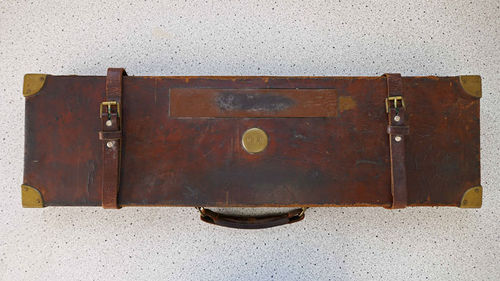
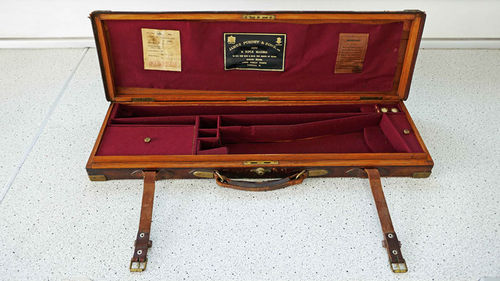
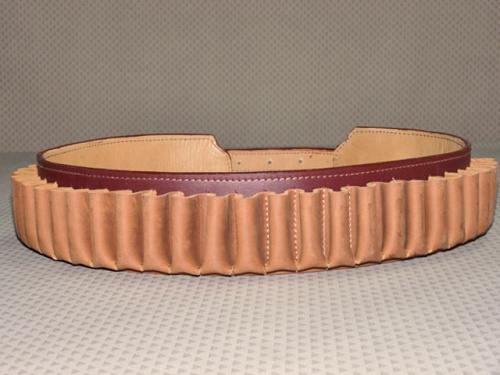

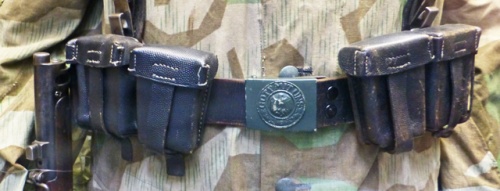












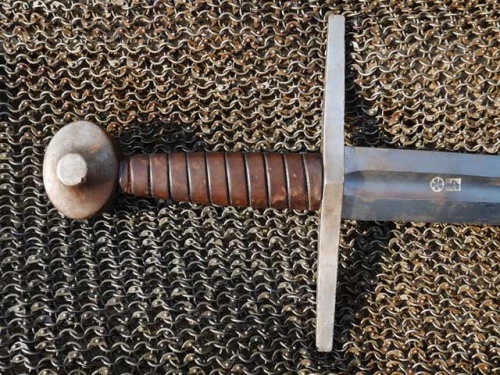

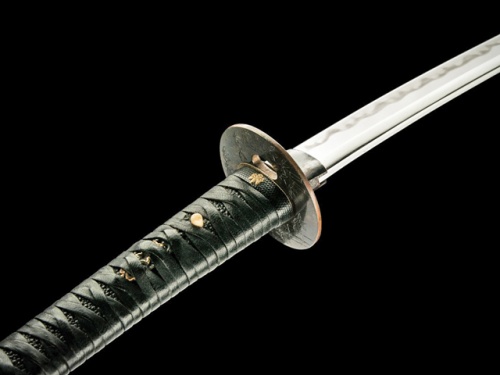


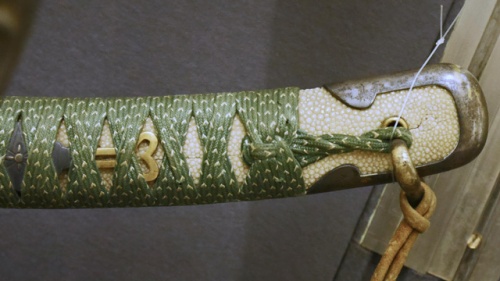
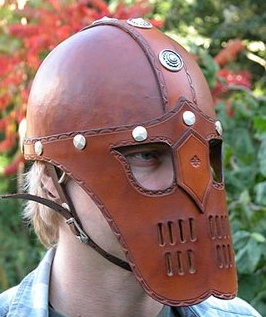

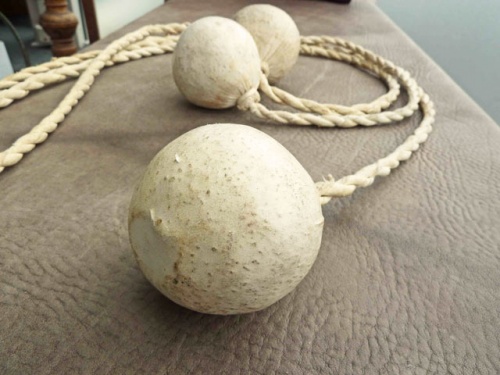







 a kotori web solution
a kotori web solution